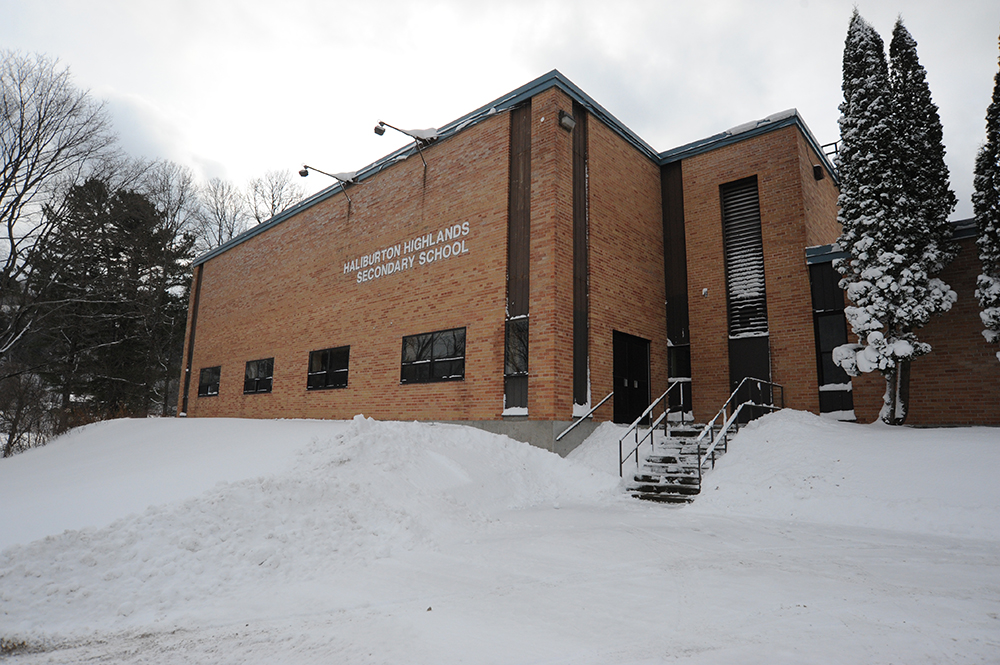The Trillium Lakelands District School Board says its water testing of Haliburton schools has found an eight per cent failure rate for lead over the past three years.
District manager of corporate communications, Catherine Shedden, was responding to a Highlander request for comment following a Toronto Star investigation that found an average failure rate of 16 per cent at six Haliburton schools and the adult education building in Haliburton.
According to The Star investigation, Haliburton Highlands Secondary School had a failure rate of 41 per cent. That meant nine out of 22 water tests revealed lead that exceeded the current federal guidelines of five parts per billion (cut from 10 ppb this past March).
Ontario has kept its benchmark at 10 ppb while it reviews Ottawa’s new guidelines.
Cardiff Elementary School had a 38 per cent failure rate according to The Star, or three of eight test results having higher than recommended lead levels.
The adult education building had a 25 per cent failure rate, with one of four tests revealing higher than recommended lead levels.
J. Douglas Hodgson Elementary School was rated at an eight per cent failure rate by the national newspaper’s investigators, with one of 12 test failures.
Archie Stouffer, Stuart Baker and Wilberforce elementary schools had zero per cent failure rates.
According to The Star’s numbers, that’s an average failure rate of 16 per cent. The Star reported last week that more than 2,400 Ontario schools and daycares exceeded the current federal guidelines in the past two years. They said it was a 275 per cent jump from two years ago, due to more frequent testing and the tougher federal lead limits. They blamed lead fixtures, including taps and water fountains, which were used in school plumbing and remain in place today.
The probe went on to say, “children, especially younger children, are particularly vulnerable to the health impacts of lead because their bodies absorb the toxin more than adults. They said lead can impact a child’s cognitive development, IQ levels and overall health. They added that according to the World Health Organization there is no safe level of lead.
TLDSB: 6 of 74 samples fail lead test
Shedden said a total of 74 samples have been obtained over the past three years in six Haliburton schools. She said six of the 74 samples have failed a standing or flushing sample, or about eight per cent. Her figures did not include the Alternative Education building in Haliburton.
She stressed that under the Ontario Drinking Water Quality Standard, Objectives and Guidelines, the Maximum Acceptable Concentration (MAC) for lead in a water supply is 10 micrograms per litre [the same as 10 parts per billion]. She said designated fixtures included fountains, hydration stations and sinks where children could obtain a drink and supplies that are used for cooking or food/drink preparation.
She said two samples are taken from each location with the first sample prior to building flushing, called a ‘standing’ sample, and the second after the building flushing. She said the provincial recommendation when there is an exceedance of lead in a ‘standing’ sample is to flush the school plumbing daily.
“Whenever results from water tests exceed the threshold for safe drinking water at a school, the TLDSB facilities services department work with the local health unit to determine the best corrective action,” Shedden said. “This could include, but is not limited to, taking the drinking water fixture out of service (which happens as soon as there is an exceedance), increase flushing, further resampling, replacement of a fixture,” Shedden said.
The health unit’s manager of environmental health, Bernie Mayer, said “Ensuring that water is safe to drink for everyone is of paramount importance to the health unit. In general, regular flushing of water from the pipes at schools – be it on a daily or weekly basis – is sufficient for getting lead levels below the Ontario benchmark of 10 ppb. The results of water samples taken after flushing are the ones that really matter.
“If there are issues with lead levels in the water at local schools, the health unit will work closely with school officials and the Ministry of Environment, Conservation and Parks to ensure the problem is fixed. Any source of unsafe drinking water (be it a fountain or fixture) will be shut down or removed from service until the situation is resolved.”





